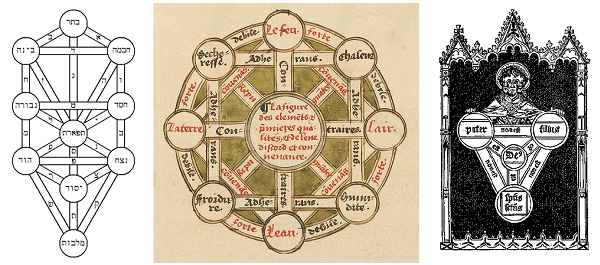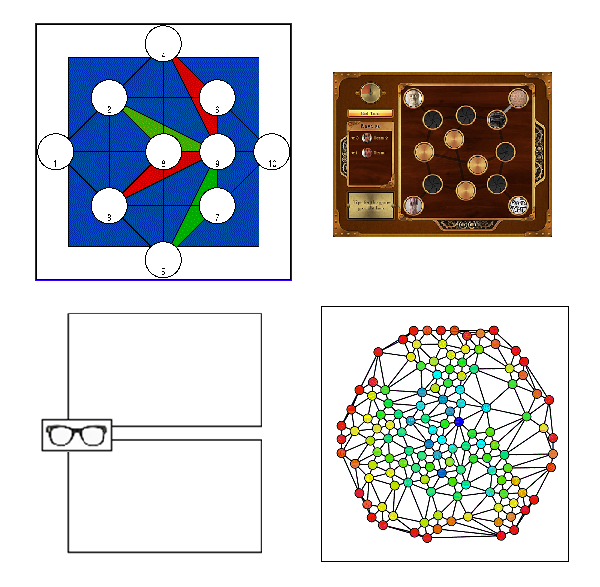Graph-types 1: sample graphs and boards
[ by Charles Cameron — background reading for the post which follows ]
.
This is a quick look at node and edge graphs and some of the boards used in HipBone, DoubleQuote, and Sembl Games — a refresher for those who already know, and a quick intro for those who may not…
Above, you’ll see two graphs — one very simple and one far more complex. What they have in common is points (known as nodes) and lines connecting them (known as edges). Graphs of this kind are instances of the basic pattern on which much of contemporary understanding of the world rests, as it mostly rested on linear thinking in previous centuries. They are everywhere.
**
In the next image, however, we see some medieval and renaissance instances of graphs in which concepts and their relations have been assigned to the nodes and their edges — these are also commonly found today, but the early versions here have a beauty all their own..
Left to right: the Sephirotic Tree of classical Jewish Kabbalah; Oronce Fine‘s diagram of the four elements; and a medieval respresentation of the Christian Trinity. It was the Reformation & Counter-Reformation that really put a stop to this kind of graphical thinking, as Ioan Couliano teaches us.
**
Finally, my HipBone Games and the Museum Game that Cath Styles designed for the National Museum of Australia use graphs as their boards, and the players assign concepts to the various nodes, establishing conceptual links between them:
Upper left, th4 standard WaterBird board for HipBone play; upper right, one of Cath’s boards for the Museum Game; lower left, the DoubleQuotes board, and lower right, a beautiful graph on which I hoped gto play a symphonic Bead Game.
**
That’s the essential background you need to proceed to the next post, Graph-types 2: towards a universal graphical mapping language, where I lay out my hopeful, hopeless scheme for a Grand Unified Map. Onwards.






February 12th, 2016 at 1:29 am
Perhaps relevant to your schemata are two metaphorical obversities I’ve wondered about:
.
One consists of “bubbles” & “black holes” — as in market and housing bubbles that collapse, leaving people in black holes of poverty.
.
The other consists of “pipe dreams” & “rabbit holes” — e.g., bright soaring pipe-dream and dark conspiratorial rabbit-hole mentalities can be found at both ends of the political spectrum, but liberals seem associated mostly with pipe dreams, while our right-wing seems increasingly fraught with rabbit-hole thinkers. Trump and Cruz in particular attract the latter: birthers, etc., etc.
.
Ever see any diagrams, images, or writings that compare / contrast bubbles and black holes, or pipe dreams and rabbit holes? Our times are full of them in any case.
February 12th, 2016 at 6:49 am
The question then becomes: how to find the metanoia to transform paranoia into eunoia, eh?
.
Thought-provoking as ever, David, and no, I haven’t seen either on diagrammed as such. On a perhaps similar tack, an acupuncturist friend once told me that when any energetic flow is blocked, there will be two symptoms — one caused by excess (akin to “flooding”) above the blockage, and the other by dearth (“desertification”) below it. I’ve found “looking for the second symptom” to be a powerful & fruitful heuristic.
February 12th, 2016 at 2:49 pm
Maybe you can think of it in terms of a light cone
https://en.wikipedia.org/wiki/World_line#World_lines_in_special_relativity
then you could set about finding the curves that connects them.
February 12th, 2016 at 2:52 pm
Or probably more up Charles’ alley are the curves that transcend them
http://physics.about.com/od/physicsatod/g/closedtimelikecurve.htm
February 12th, 2016 at 4:15 pm
And I always thought CTC meant the Combating Terrorism Center at West Point!
February 12th, 2016 at 7:22 pm
charles — that’s an impressive string of -noia words. umm, they seem ripe for knock-knock jokes: knock, knock. who’s there? eunoia. eunoia who? you know ya … [fill in the rest]. rather like richard armour’s classic knock-knock about euripedes.
.
grurray — excellent references and light-cone imagery. i like the bits about time-travel, for most right-wing rabbit-hole believers i’ve noticed would like go back to a simpler past. in contrast, many pipe-dreamers tend to be futuristic utopians, the ones on the left anyways. or so i’d over-simplify. plus, dare i say, cough-cough reflecting the main image you provided, that lots of rabbit-hole and pipe-dream thinkers turn out to be light cone-heads.